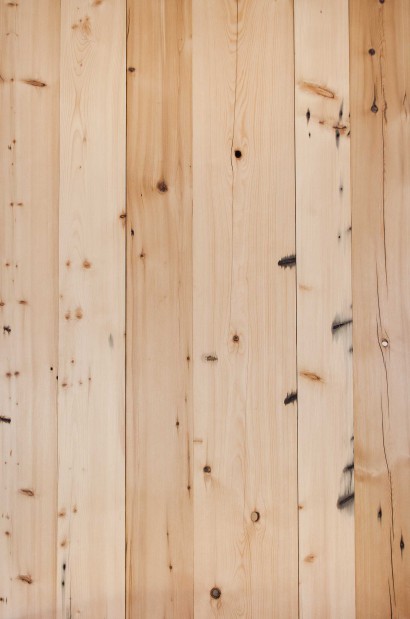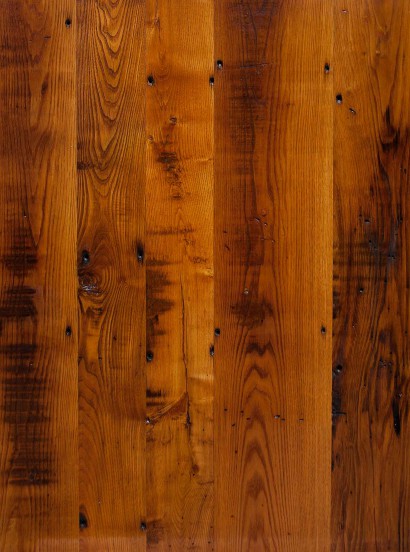Congratulations! You're the lucky owner of a reclaimed wood floor. We'll give you the good news first: Reclaimed hardwood floors will last for hundreds of years. The bad news: You're probably the one who has to keep them clean. Luckily, maintaining a reclaimed wood floor is no different from cleaning a new wood floor. Knowing how to clean your wood floors can be broken down into two important steps: preventing initial wear and damage to your floor and cleaning the finish.
PREVENTION:
Your first goal in maintaining your reclaimed wood floor's appearance is to protect the finish from wear and damage. Regardless of the finish (oil-based, water-based, etc.) or the type of flooring (hardwood or softwood, etc.), these steps are the same.
Keep floors clear of dirt, sand, and other grit. When small pieces of grit are caught beneath feet, rugs, or furniture, they drag along the surface of the flooring and scratch the finish. Regular sweeping with a soft bristle broom is the best way to accomplish this. Vacuuming can also work but be careful that the hose attachment, vacuum wheels, or floor brushes do not scratch the floors. Dry mopping can also be effective, but avoid those treated with chemicals, as they may dull your finish.
- Use floor protectors on furniture legs. Felt pads attached to the bottoms of chairs, sofas, dressers, and other furniture go a long way towards protecting your floor from scratches. Lift and carry furniture over your floors - never drag, push, or pull.
- Place doormats at entrances and ask visitors to wipe their shoes before entering. Better yet - try a 'no shoes in the house' rule!
- Manage spills by wiping up liquids as soon as possible. A water-dampened cloth may be sufficient but oil-based liquids (cooking grease, oil, etc.) may require a small amount of dish soap to help collect the oil. In all cases, you should avoid using large amounts of water while cleaning and be sure to dry the area afterward.
Keep high heels and pets with sharp claws off your reclaimed wood floors! These are surefire ways to dent softer species such as white pine and spruce, and can even damage harder species such as oak and reclaimed heart pine.
- If your room has area rugs, avoid backings and slip pads that may damage your floor’s finish. Natural fiber backings such as jute and wool are preferable to plastic. Check periodically for transfer of dye from your rug.
- Control the humidity in the room. All wood floors will appreciate your efforts to maintain the most climate-stable environment possible.
CLEANING:
When it comes to cleaning your floors, the first step is to check the finish manufacturer's recommendations for your particular floor finish, as well as seek the advice of your floor finisher. There are many different kinds of finish and many different manufacturers of each. Every floor finish is unique and should be treated as such. As you ask yourself "What is the best wood floor cleaner?", you should keep in mind that various floor finish treatments are affected by cleaning products in different ways and to different degrees. Longleaf Lumber does not claim expertise in this field, as we are not floor finishers ourselves. Below are general guidelines to help in your decision on which product is right for you, as well as a few thoughts on what to avoid.
Almost all proponents of different methods agree on one thing: Moisture is not your friend when it comes to wood flooring. Too much liquid - especially when applied to worn finish or unfinished wood - will most certainly cause damage. Water can affect the ability of finish to adhere to wood and can cause swelling, which leads to cupping of floorboards. Wet mopping and steam cleaning are out of the question.
CLEANING YOUR SURFACE-SEALED FLOOR:
Surface sealers, such as polyurethane, resist stains and damage caused by water. When cleaning these floors, we are cleaning the protective surface finish and not the wood itself. Plain water on a slightly damp cloth may the best method of them all. Some suggest that heavier grime buildup or oily stains may benefit from a small amount of mild or pH-neutral soap. Gentle cleansers made specifically for wood flooring are usually considered safe options. Even after using these methods, however, residue may remain. Anything left on the floor should be wiped away with plain warm water.
Harsh chemicals and abrasives are to be avoided as they can dull or erode your finish. Liquid polishes, furniture sprays, and floor waxes can leave a residue or create slippery surfaces. Oil-based soaps have been found to dull finishes and can nullify a warranty. Acidic liquids, such as vinegar, can degrade finish and ammonia can discolor your floor. We understand that there are many who swear by the effectiveness of some of these common methods. Because almost all cleaners will have a negative impact on your finish, your choice may be to simply minimize this damage by using the smallest necessary amount of your chosen cleaner. Use liquids only when necessary, and dry the surface when you are done.
CLEANING YOUR OILED FLOOR:
Oils penetrate wood floors but are not themselves water-resistant. Some oil finishes, like the Waterlox brand tung oil that we recommend, also contain poly-resins that harden after the finish has soaked into the wood’s grain, granting greater protection against moisture and stains.
For the most part, however, preventative maintenance is the primary method for keeping an oiled floor looking its best. Wood soap cleaners can be used with water and a damp mop to both clean and restore small amounts of oil to the wood, and products with a range of oil-restoring abilities also exist. Eventually, however, oil is re-applied to the floors to restore their finish. Because we recommend Waterlox tung oil to our customers who desire an oiled floor, we also recommend Waterlox brand floor cleaner, which you can buy from us or other distributors. Other manufacturers of oils do the same for their products.
CLEANING YOUR WAXED FLOOR:
Waxed floors sometimes have a penetrating finish beneath the wax, or the wax may have been applied directly over raw wood floorboards. The surface wax layer has been applied as a paste or liquid and is then buffed to the desired finish. In some respects, waxed floors are similar to oil-treated floors - preventative work with a broom is your best weapon against damage. Waxed floors differ, however, in that they should never be mopped. Eventually, waxed floors will need to be stripped and re-waxed to provide a clean new finish.
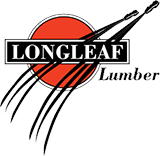
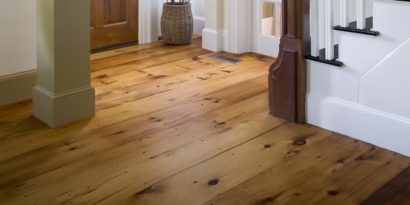
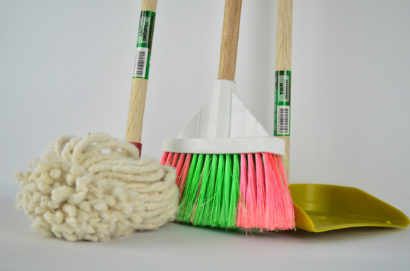 Keep floors clear of dirt, sand, and other grit. When small pieces of grit are caught beneath feet, rugs, or furniture, they drag along the surface of the flooring and scratch the finish. Regular sweeping with a soft bristle broom is the best way to accomplish this. Vacuuming can also work but be careful that the hose attachment, vacuum wheels, or floor brushes do not scratch the floors. Dry mopping can also be effective, but avoid those treated with chemicals, as they may dull your finish.
Keep floors clear of dirt, sand, and other grit. When small pieces of grit are caught beneath feet, rugs, or furniture, they drag along the surface of the flooring and scratch the finish. Regular sweeping with a soft bristle broom is the best way to accomplish this. Vacuuming can also work but be careful that the hose attachment, vacuum wheels, or floor brushes do not scratch the floors. Dry mopping can also be effective, but avoid those treated with chemicals, as they may dull your finish.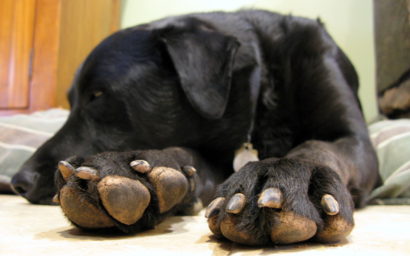 Keep high heels and pets with sharp claws off your reclaimed wood floors! These are surefire ways to dent softer species such as white pine and spruce, and can even damage harder species such as oak and reclaimed heart pine.
Keep high heels and pets with sharp claws off your reclaimed wood floors! These are surefire ways to dent softer species such as white pine and spruce, and can even damage harder species such as oak and reclaimed heart pine.